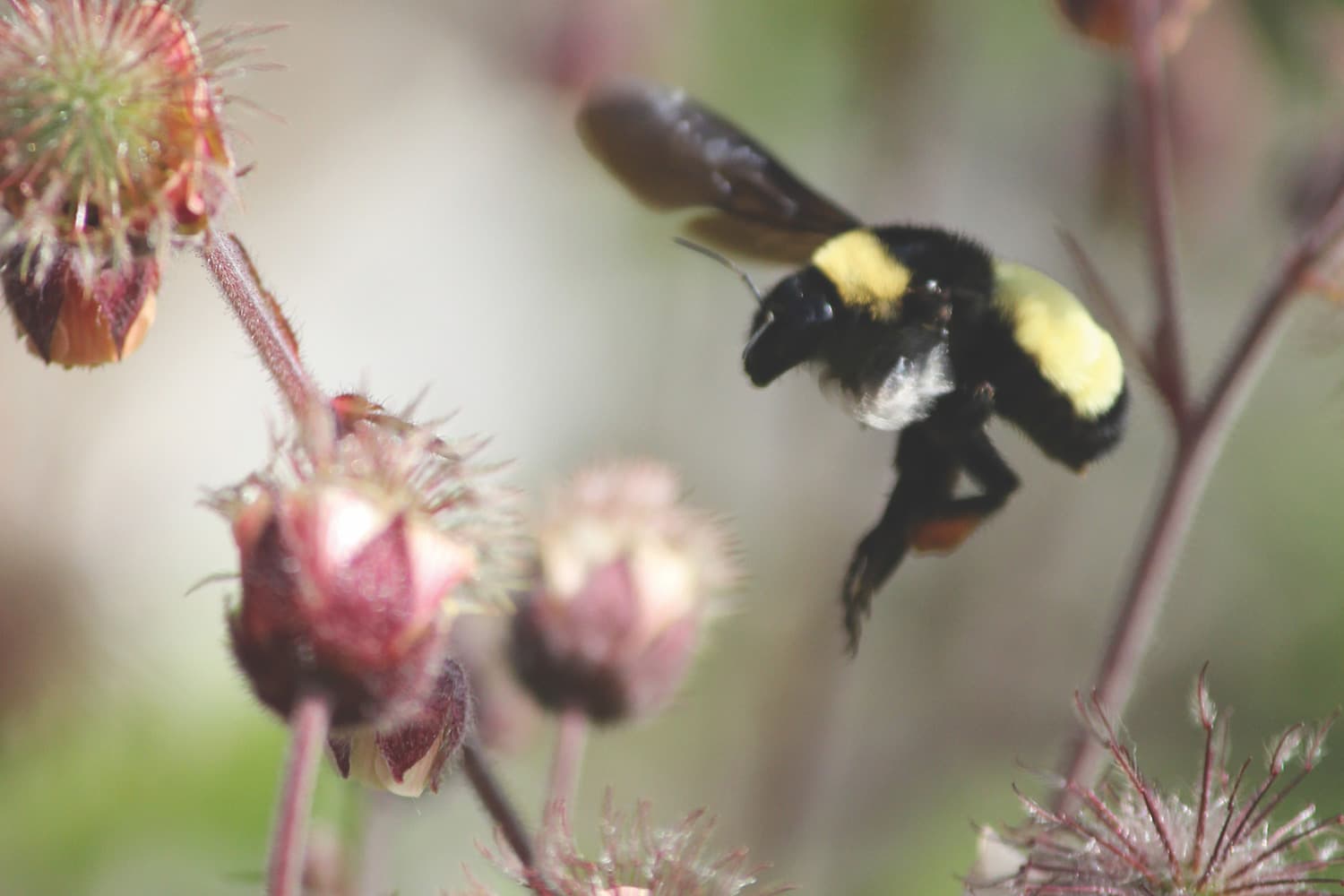Rewilding Your Lawn is Worth the Work
Instead of biodiversity-busting grass, please the bees with a yard full of native plants.
We are surrounded by lawns. Whether we have a lawn ourselves or simply pass other people’s during our daily routine, lawns are a common part of life for most of us—and they affect the world more than you might think.
Typical grass lawns in the cooler regions of North America, including BC, are grown from a blend of non-native grasses such as Kentucky bluegrass, ryegrass, and fescue. By stripping the land of its native species and robbing creatures of their homes and food sources, their widespread presence contributes to the loss of biodiversity. These hyper-managed and manicured lawns don’t just harm plants, animals, and insects: they harm soil, water, climate, and yes—even people.
The solution to this? Rewilding our lawns.
For homeowners, lawn-rewilding can look like converting part or all of their mowed, fertilized, and raked lawns into vibrant areas filled with a variety of plant species. The word “rewilding” might sound intimidating; however, Stephen Murphy, a rewilding expert and professor of ecology at the University of Waterloo, tells Asparagus that we can think of it in more familiar terms like “bringing back nature” or “restoration.” When we look at rewilding our lawns simply as making changes that invite nature back into our yards, it becomes less like a daunting task and more like an exciting adventure!
The simplest way to rewild your lawn is to pull up your current turf and replace it with a garden—ideally, one featuring lots of native and pollinator-friendly plants. However, if you prefer to do it more gradually and end up with something of a lawn-like space, here are the basic steps:
1. Choose the area that you want to rewild.
To avoid ending up with a patchwork of conventional lawn and lawn alternatives, aim for a continuous area. This could be, for instance, a band around the perimeter of your lawn, a strip along the side or back, a patch that has always been tricky to get the mower into, or a place containing invasive weeds that you’re tired of dealing with.
Remember that you can do this over several years, so no need to fret about where to start. Starting small can make the transition to a wild lawn easier—and might help your neighbours accept the idea of a non-conventional lawn in their area, too. Murphy points out, “If everybody does those small incremental steps, just like anything else, it’s like creating a community, creating a series of friendships.”
2. Remove the grass from your chosen area.
There are several ways to do this. You could cut out the lawn turf, being sure to get all the roots so that they don’t compete with the new plants. For a less labour-intensive process, simply stop fertilizing and watering the area. This approach is slower, but the grass will eventually start to thin out and make space for you to sow seeds. If you choose this way, be aware that you’ll still need to remove the roots of the old lawn grass: even dead, they are thick enough to keep your new seeds from establishing.
In between these fast and slow approaches is the more moderate “sheet mulching” method. This involves putting down sheets of cardboard or newspaper, applying a thin layer of soil on top, and keeping the whole thing consistently damp for six to eight weeks. In effect, you are composting your lawn!
This method has many benefits. First, it feeds the beneficial microorganisms in your soil as they ingest and break down the paper pulp. Second, you can sow some seeds in the soil on top of the sheets right away, as long as they are for shallow-rooted plants, such as short wildflowers, that won’t puncture the newspaper or cardboard sheets: no need to wait. It also prevents damage to the soil structure—even adding beneficial organic material.
3. Choose your replacement.
There are many options, from short and tall wildflower blends to microclover and native fescue grasses. For the greatest biodiversity benefits, sow enough of a variety of native seeds that you will have plants growing and flowering throughout the growing season. Follow the instructions on the seed bag regarding soil preparation and sowing.
4. Keep the area watered.
Seeds will only germinate if they’re kept moist. Once they’ve grown in, step back, assess, and adjust your seed choices if you’d like to. Then continue on until you’ve rewilded as much of your lawn as you want.
Once the rewilding of your chosen area is underway, you can turn your attention to a more sustainable way of managing the conventional lawn that you still have. Start by forgetting everything you’ve been taught about lawn care. Opt out of mowing, fertilizing, clearing away the leaves, and adding colourants. If you do choose to mow, cut the grass high and leave the clippings on the ground to break down.
Regardless of your chosen approach, patience and intention are key to successful rewilding. It’s important to remember that change might occur slowly. “Abundance doesn’t happen immediately,” Murphy says. “Just because you go back and rewild something, it doesn’t mean that nature magically heals.”
Whether you’re able to fully uproot a yard and replace it with native species, mow your grass less and let the clippings become mulch, or simply learn the names of a couple of native species in your area, your efforts contribute to the process of rewilding. Remember that you can start small and invite nature back into the places it belongs. Hopefully that invitation doesn’t feel so intimidating.
This story was first published on The Green House, our membership platform. Join us there for early access, discounts and freebies, community discussions, and to support our work telling the large and small stories of how we can live sustainably.
